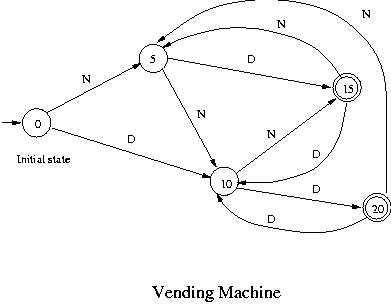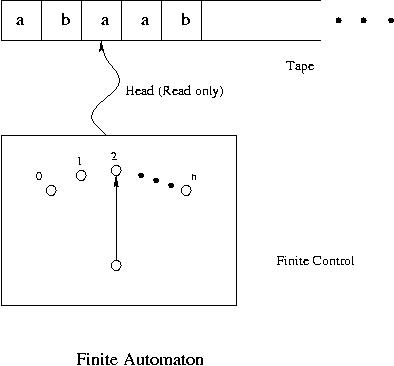Finite Automata
Definition of Deterministic Finite Automata
Subjects to be Learned
- Finite automata
- State transition diagram
- State transition table
Contents
Here we are going to formally define finite automata, in particular deterministic finite automata
and see some examples. Finite automata recognize regular
languages and, conversely, any language that is recognized by a finite automaton is regular.
There are other types of finite automata such as nondeterministic finite automata and nondeterministic automata
with  and they are going to be studied later.
and they are going to be studied later.
Let us now formally define deterministic finite automaton.
Definition of deterministic finite automaton
Let Q be a finite set and let  be a finite set of symbols.
Also let
be a finite set of symbols.
Also let  be a function
from Q
be a function
from Q 
 to Q , let q0 be a state in Q and
let A be a subset of Q.
We call the elements of Q a state,
to Q , let q0 be a state in Q and
let A be a subset of Q.
We call the elements of Q a state,
 the transition function,
q0 the initial state
and A the set of accepting states.
the transition function,
q0 the initial state
and A the set of accepting states.
Then a deterministic finite automaton is a 5-tuple
< Q ,  ,
q0 ,
,
q0 ,  , A >
, A >
Notes on the definition
- The set Q in the above definition is simply a set with a finite number of elements. Its elements can,
however,
be interpreted as a state that the system (automaton) is in. Thus in the example of vending machine,
for example, the states of the machine such as "waiting for a customer to put a coin in",
"have received 5 cents" etc. are the elements of Q. "Waiting for a customer to put a coin in"
can be considered the initial state of this automaton and the state in which the machine gives out
a soda can can be considered the accepting state.
- The transition function is also called a next state function
meaning that the automaton moves into the
state
 (q, a) if it receives the input symbol a while in state q.
(q, a) if it receives the input symbol a while in state q.
Thus in the example of vending machine, if q is the initial state and a nickel is
put in, then  (q, a) is equal to "have received 5 cents".
(q, a) is equal to "have received 5 cents".
- Note that
 is a function. Thus for each state q of Q
and for each
symbol a of
is a function. Thus for each state q of Q
and for each
symbol a of  ,
,
 (q, a) must be specified.
(q, a) must be specified.
- The accepting states are used to distinguish sequences of inputs given to the finite automaton.
If the finite automaton is in an accepting state when the input ceases to come, the sequence of
input symbols given to the finite automaton is "accepted". Otherwise it is not accepted. For example,
in the Example 1 below, the string a is accepted by the finite automaton. But any other strings
such as aa, aaa, etc. are not accepted.
- A deterministic finite automaton is also called simply a "finite automaton".
Abbreviations such as FA and DFA
are used to denote deterministic finite automaton.
DFAs are often represented by digraphs called
(state) transition diagram.
The vertices (denoted by single circles) of a transition diagram represent
the states of the DFA and the arcs
labeled with an input symbol correspond to the transitions. An arc ( p , q )
from vertex p to vertex q with label  represents the transition
represents the transition
 (p,
(p,  ) = q .
The accepting states are indicated by double circles.
) = q .
The accepting states are indicated by double circles.
Transition functions can also be represented by tables as seen below.
They are called
transition table.
Examples of finite automaton
Example 1: Q = { 0, 1, 2 },  = { a }, A = { 1 },
the initial state is 0 and
= { a }, A = { 1 },
the initial state is 0 and  is as shown in the following table.
is as shown in the following table.
| State (q) | Input (a) | Next State (  (q, a) )
(q, a) ) |
0 | a | 1 |
1 | a | 2 |
2 | a | 2 |
A state transition diagram for this DFA is given below.

If the alphabet  of the Example 1 is changed to { a, b } in stead of
{ a }, then we need a DFA such as shown in the following examle to accept the same string a.
It is a little more complex DFA.
of the Example 1 is changed to { a, b } in stead of
{ a }, then we need a DFA such as shown in the following examle to accept the same string a.
It is a little more complex DFA.
Example 2: Q = { 0, 1, 2 },  = { a, b }, A = { 1 },
the initial state is 0 and
= { a, b }, A = { 1 },
the initial state is 0 and  is as shown in the following table.
is as shown in the following table.
| State (q) | Input (a) | Next State (  (q, a) )
(q, a) ) |
0 | a | 1 |
0 | b | 2 |
1 | a | 2 |
1 | b | 2 |
2 | a | 2 |
2 | b | 2 |
Note that for each state there are two rows in the table for  corresponding to the symbols a and b, while in the Example 1 there is only one row for each state.
corresponding to the symbols a and b, while in the Example 1 there is only one row for each state.
A state transition diagram for this DFA is given below.

A DFA that accepts all strings consisting of only symbol a over the alphabet { a, b }
is the next example.
Example 3: Q = { 0, 1 },  = { a, b }, A = { 0 },
the initial state is 0 and
= { a, b }, A = { 0 },
the initial state is 0 and  is as shown in the following table.
is as shown in the following table.
| State (q) | Input (a) | Next State (  (q, a) )
(q, a) ) |
0 | a | 0 |
0 | b | 1 |
1 | a | 1 |
1 | b | 1 |
A state transition diagram for this DFA is given below.

Example 4: For the example of vending machine of the previous section, Q = { 0, 5, 10, 15, 20 },
 = { D, N }, A = { 15, 20 }, the initial state q0 = 0.
If we make it a DFA,
its transition function
= { D, N }, A = { 15, 20 }, the initial state q0 = 0.
If we make it a DFA,
its transition function  is as shown in the following table.
is as shown in the following table.
| State (q) | Input (a) | Next State (  (q, a) ) (q, a) ) |
0 | N | 5 |
0 | D | 10 |
5 | N | 10 |
5 | D | 15 |
10 | N | 15 |
10 | D | 20 |
15 | N | 5 |
15 | D | 10 |
20 | N | 5 |
20 | D | 10 |

A finite automaton as a machine
A finite automaton can also be thought of as the device shown below consisting of a tape
and a control circuit which satisfy the following conditions:
- The tape has the left end and extends to the right without an end.
- The tape is divide into squares in each of which a symbol can be written
prior to the start of the operation of the automaton.
- The tape has a read only head.
- The head is always at the leftmost square at the beginning of the operation.
- The head moves to the right one square every time it reads a symbol.
It never moves to the left.
When it sees no symbol, it stops and the automaton terminates its operation.
- There is a finite control which determines the state of the automaton
and also controls the movement of the head.

Operation of finite automata
Let us see how an automaton operates when it is given some inputs.
As an example let us consider the DFA of Example 3 above.
Initially it is in state 0. When zero or more a's are given as an input to it,
it stays in state 0 while it reads all the a's (without breaks) on the tape.
Since the state 0 is also the accepting state,
when all the a's on the tape are read, the DFA is in the accepting state.
Thus this automaton
accepts any string of a's. If b is read while it is
in state 0 (initially
or after reading some a's), it moves to state 1. Once it gets to state 1,
then no matter what
symbol is read, this DFA never leaves state 1. Hence when b appears anywhere
in the input, it goes into state 1 and the input string is not accepted
by the DFA. For example strings aaa, aaaaaa etc. are accepted but strings
such as aaba, b etc.
are not accepted by this automaton.
Test Your Understanding of Definition of DFA
Indicate which of the following statements are correct and which are not.
Click Yes or No , then Submit.
There are two sets of questions.
Next ---  * and its Properties
* and its Properties
Back to Study Schedule
Back to Table of Contents
 (q, a) if it receives the input symbol a while in state q.
(q, a) if it receives the input symbol a while in state q.
 (q, a) is equal to "have received 5 cents".
(q, a) is equal to "have received 5 cents".
 is a function. Thus for each state q of Q
and for each
symbol a of
is a function. Thus for each state q of Q
and for each
symbol a of  ,
,
 (q, a) must be specified.
(q, a) must be specified.
 and they are going to be studied later.
and they are going to be studied later.

 represents the transition
represents the transition




